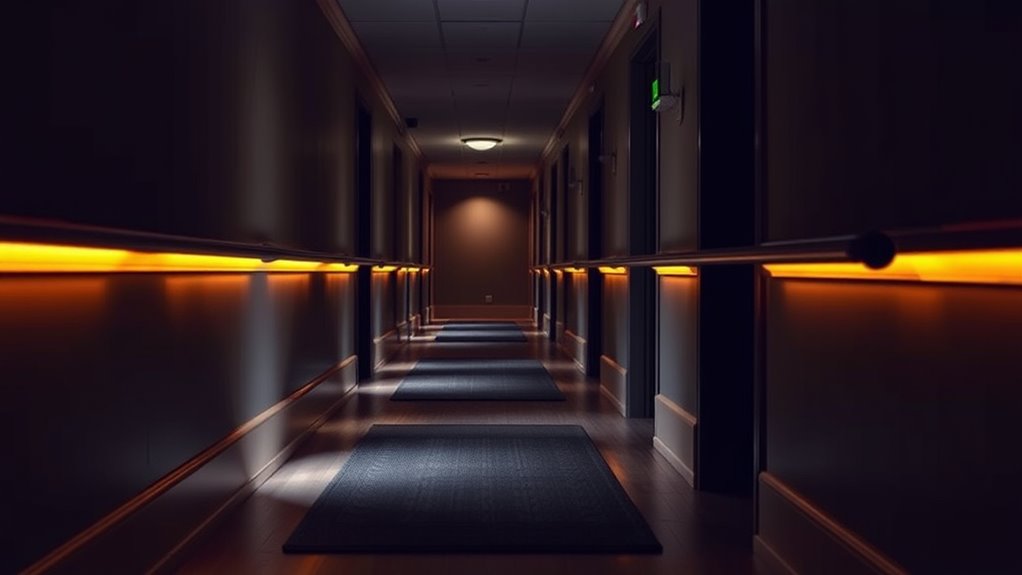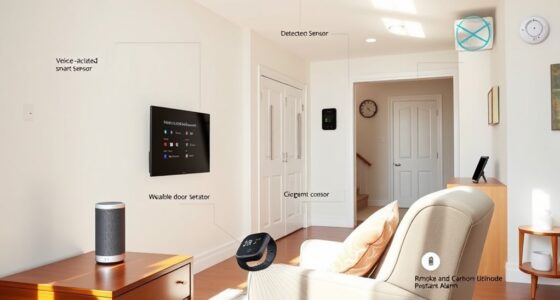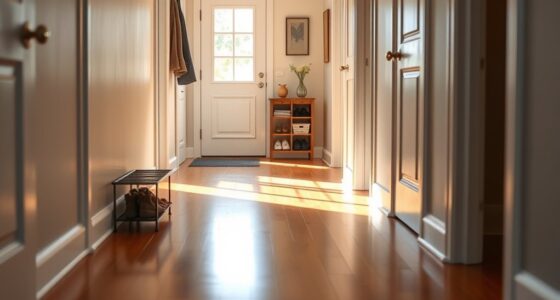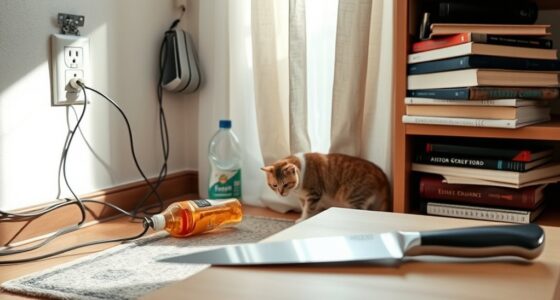To reduce nighttime falls, improve your home’s lighting by adding pathway lights and installing night lights in key areas like hallways, bathrooms, and near your bed. Use motion sensors for automatic lighting that turns on when needed, preventing stumbling in the dark. Choose warm, soft bulbs, and guarantee switches are easy to access and clearly marked. Proper placement and glare reduction make a big difference—keep exploring ways to make your home safer tonight.
Key Takeaways
- Install well-lit pathways and staircases with motion sensors to ensure visibility and automatic lighting activation.
- Use night lights in hallways, bathrooms, and bedrooms to guide safe movement during nighttime.
- Choose bulbs with warm color temperatures and dimmable features to reduce harsh shadows and glare.
- Position switches conveniently near entrances and along hallways for easy access in the dark.
- Incorporate lighting fixtures with glare reduction and even distribution to minimize shadows and hazards.
Enhance Pathway Lighting Throughout the Home
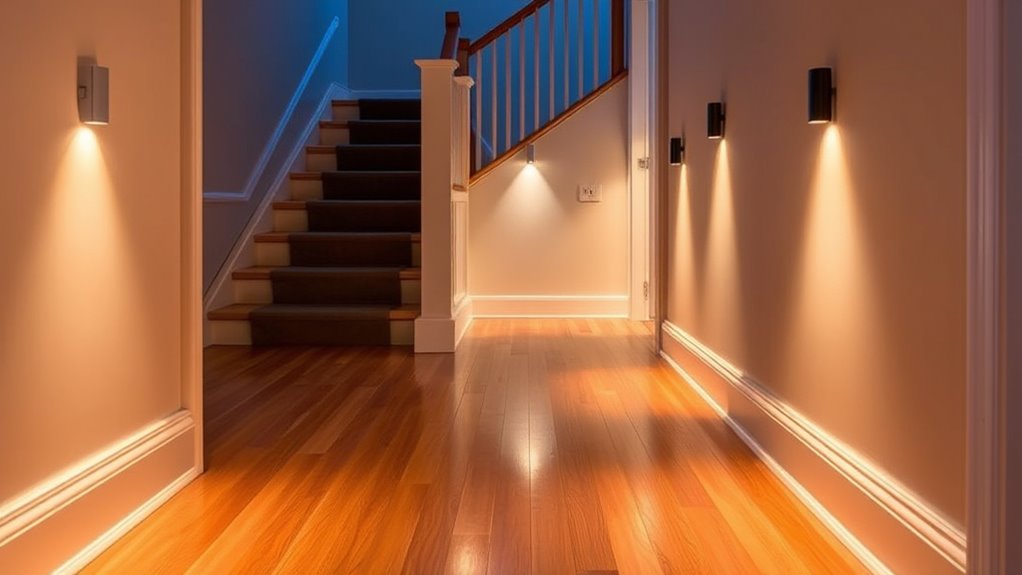
To prevent falls during the night, you should prioritize enhancing pathway lighting throughout your home. Start by improving your outdoor landscape lighting to clearly illuminate walkways, gardens, and entry points. Well-lit outdoor paths reduce the risk of tripping over uneven surfaces or obstacles. Additionally, focus on staircase lighting, ensuring each step is clearly visible. Install strip lights or motion-activated fixtures along staircases to provide consistent illumination without glare. Properly lit pathways and stairs help you navigate safely in the dark, especially when you’re groggy or in a hurry. Keep lighting consistent and avoid shadows that can hide hazards. By making these targeted improvements, you’ll create a safer environment and considerably reduce your chances of nighttime falls.
Install Night Lights in Key Areas

Installing night lights in key areas helps you see clearly without turning on harsh overhead lighting. Place them in hallways, near bathroom entrances, and along bedroom paths for added safety. These small changes can make a big difference in preventing nighttime falls. For those interested in eco-friendly solutions, electric power generation with bike generators offers an innovative way to harness renewable energy to power your lighting.
Strategically Place in Hallways
Have you considered how strategic placement of night lights in hallways can considerably reduce the risk of falls during nighttime trips? Positioning lights at key points ensures safe navigation without blinding brightness. Choose fixtures with styles that blend seamlessly into your decor, avoiding obtrusive or outdated designs. Focus on creating strong color contrast between the wall and the light to guide your eyes naturally along the corridor. Install lights at a low height, close to the floor or just above eye level, to illuminate the path effectively. This setup helps you see potential hazards clearly while maintaining a calming ambiance. Properly placed night lights make your hallway safer, reducing the likelihood of missteps and falls during late-night movements. Lighting placement plays a crucial role in creating a safe environment.
Brighten Bathroom Entrances
Ever thought about how illuminating your bathroom entrance can prevent nighttime accidents? Installing night lights with decorative fixtures ensures your space is both functional and stylish. Choose fixtures that blend seamlessly with your decor, avoiding harsh glare. Pay attention to color temperature; warmer tones create a cozy, non-distracting glow, while cooler temperatures offer brighter visibility. Position these lights strategically near doorways and along the floor to guide your way safely. Battery-operated or plug-in options provide flexible placement without complex wiring. Brightening your bathroom entrance with well-chosen night lights reduces the risk of trips and falls during late-night visits. By combining aesthetic appeal with practical lighting, you create a safer environment that promotes confidence and independence at night.
Light Up Bedroom Paths
Adding night lights along your bedroom paths helps create a safe and inviting environment for nighttime movement. Consider smart bulb options that allow you to easily turn lights on and off or adjust brightness with a smartphone app. These bulbs often support color temperature adjustments, so you can set a warm glow to reduce glare and prevent disorientation. Placing night lights near the bed, bathroom, and hallway ensures you can see obstacles clearly without fumbling in the dark. Choose fixtures with motion sensors for automatic activation, reducing the risk of forgetting to turn lights off. Proper lighting not only enhances safety but also helps maintain a calming atmosphere, making nighttime trips less stressful and more secure. Additionally, selecting lights with high color accuracy can help differentiate objects clearly and prevent accidental trips.
Use Motion Sensors for Automatic Illumination
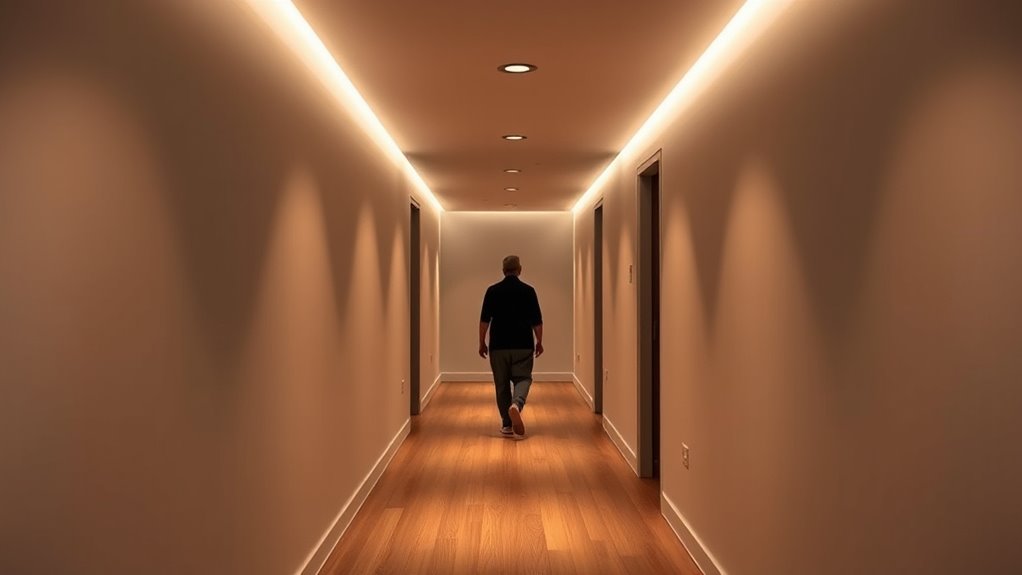
Installing motion sensors is quick and straightforward, making it an easy upgrade to your lighting. They also save energy by turning lights off when not needed, reducing electricity bills. Plus, they help prevent tripping accidents by ensuring areas are well-lit as soon as you enter. Additionally, integrating security sensors can deter burglars, providing an extra layer of safety during nighttime hours.
Easy Installation Process
Using motion sensors for automatic illumination makes the installation process quick and straightforward. You don’t need complex wiring or professional help—just some basic tools for a DIY installation. Most motion sensor lights come with clear instructions, making setup simple even if you’re not experienced with smart wiring. You’ll typically mount the sensor in a desired spot, connect it to your existing wiring (or use wireless models), and adjust the sensitivity. The process usually takes less than an hour, saving you time and money. Plus, many models are designed for easy integration with existing fixtures, so you won’t have to overhaul your current setup. With minimal effort, you can enjoy automatic lighting that enhances safety and reduces night‑time falls. Additionally, employing innovative smart technology in your lighting can further optimize energy use and improve overall home security.
Energy Efficiency Benefits
Motion sensors for automatic illumination substantially boost energy efficiency by ensuring lights are only on when needed. This prevents unnecessary energy waste, helping you save on electricity bills and reduce your carbon footprint. By integrating motion sensors with solar panels, you can further enhance sustainability, as solar-powered lights require less grid energy. Regular energy audits can identify areas where sensor use maximizes savings and efficiency. Additionally, Audi Tuning techniques can be employed to customize lighting systems for improved visibility and safety during night-time driving.
Prevents Tripping Accidents
By ensuring lights turn on only when needed, motion sensors considerably reduce the risk of tripping in dark or poorly lit areas. Smart light bulbs with motion sensors activate automatically as you approach, eliminating the need to fumble for switches. You can also customize the color temperature of these bulbs to match natural lighting, making the space more comfortable and reducing eye strain. When the sensor detects movement, it instantly illuminates pathways, stairs, or hallways, helping you navigate safely. This reduces the chance of missteps or falls caused by sudden darkness. Additionally, adjusting the color temperature to warmer tones can create a more relaxing environment while maintaining visibility. Using motion sensors with smart bulbs is an effective way to prevent tripping accidents during nighttime hours.
Minimize Glare With Proper Light Placement
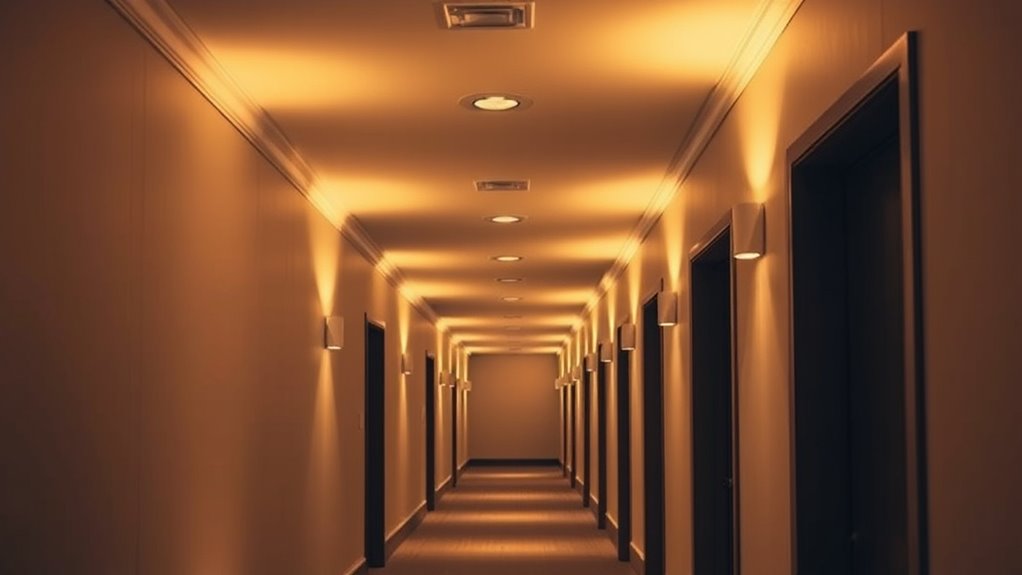
Proper light placement is essential for minimizing glare and ensuring safe navigation at night. When you position lights correctly, you reduce harsh reflections that cause discomfort and impair your vision. Focus on avoiding direct glare into your eyes by angling fixtures downward or using shields. Choosing the right light color also plays a crucial role—warm tones tend to lessen glare and create a softer environment. Additionally, understanding relationships can help you communicate your lighting needs effectively with others to ensure optimal placement.
Here are some tips:
- Use fixtures with glare reduction features like diffusers or shields
- Position lights closer to the floor or lower on walls to prevent direct eye contact
- Opt for warm-colored bulbs to soften harsh contrasts and improve visibility
Proper light placement helps you see clearly without discomfort, making nighttime movement safer and more comfortable.
Opt for Warm, Soft Lighting to Reduce Shadows
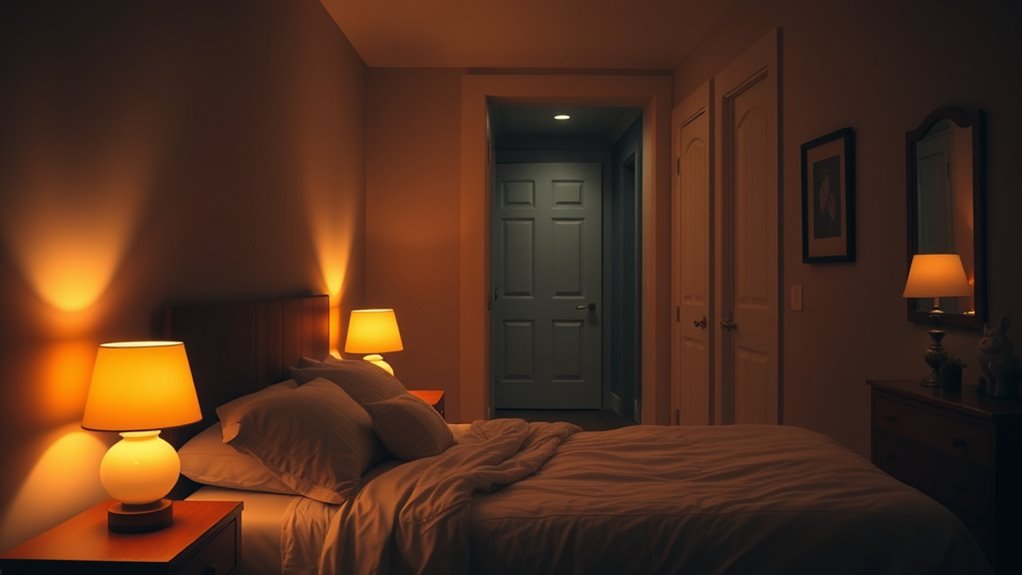
Choosing warm, soft lighting can considerably reduce shadows that cause confusion and increase the risk of falls at night. Select bulbs with a low color temperature, around 2700K, to produce gentle, inviting light. Use dimmable bulbs to adjust brightness based on your needs, avoiding overly bright or harsh lighting. The goal is to create an environment that minimizes sharp shadows, which can obscure obstacles and cause missteps. Visualize this environment with the following:
| Warm, Soft Light | Moderate Brightness | Reduced Shadows |
|---|---|---|
| Gentle Glow | Soft Illumination | Clearer Pathways |
| Cozy Atmosphere | Not Overpowering | Less Confusing |
| Comfortable | Balanced Light | Safer Night-time |
| Inviting Environment | Less Glare | Improved Visibility |
Additionally, incorporating proper lighting placement can further enhance safety by evenly distributing light and eliminating dark corners.
Keep Light Switches Accessible and Clearly Marked

Ensuring light switches are easy to find and operate can substantially improve safety at night. You want accessible switches near entrances and along hallways so you don’t have to fumble in the dark. Clear labeling helps distinguish switches for different areas, reducing confusion and hesitation. Consider installing switches at a comfortable height and using contrasting colors or large labels for better visibility. Incorporating ergonomic solutions like large, easy-to-press buttons can further enhance accessibility and safety.
- Use accessible switches with large, easy-to-press buttons
- Add clearly marked labeling for quick identification
- Keep switches unobstructed and easy to reach from your bed or chair
Making switches accessible and clearly marked minimizes risks and helps you navigate safely in low light. These simple adjustments can prevent falls and give you peace of mind during nighttime movements. Prioritize accessibility and clarity to create a safer, more comfortable environment.
Frequently Asked Questions
How Can Smart Lighting Systems Improve Safety During Nighttime?
Smart lighting systems can notably enhance safety during nighttime by using motion sensors to automatically turn on lights when you enter a room, reducing the risk of falls. Voice activation allows you to control lighting hands-free, making it easier to navigate in the dark without searching for switches. These features guarantee your environment is well-lit when needed, helping you move confidently and safely through your space at night.
Are There Specific Light Bulb Types Best Suited for Reducing Falls?
Did you know that using the right light bulb can cut fall risks by up to 50%? For better safety, opt for LED bulbs, which offer longer light bulb longevity and are part of energy-efficient fixtures. These bulbs provide bright, consistent lighting, reducing shadows and glare that can cause trips. Choosing the right bulbs helps you stay safe at night while also saving energy and money in the long run.
Can Adjustable Lighting Help Elderly Individuals Navigate More Safely?
Adjustable lighting definitely helps you navigate more safely at night. By adjusting the color temperature, you can create a warmer, soothing environment that reduces glare and confusion. Proper lighting placement ensures key areas like hallways and stairs are well-lit without causing shadows. You can tailor the light levels to your needs, making movement easier and lowering the risk of falls. This simple change considerably boosts safety for elderly individuals.
What Are the Cost Differences Between Various Lighting Solutions?
When you look at the cost analysis of different lighting solutions, you’ll find significant differences. Basic night lights are the most budget-friendly, often costing under $10, but may lack adjustable features. Motion-activated or smart lighting options cost more, usually between $20 and $100, yet offer better safety. Consider your budget considerations carefully to choose a solution that balances affordability and safety, ensuring you get the most value for your money.
How Often Should Lighting Be Checked or Maintained for Safety?
You should check and maintain your lighting regularly to guarantee safety. Establish consistent lighting schedules and maintenance routines—at least once every three to six months—to identify flickering bulbs, burnt-out lights, or electrical issues. Regular inspections help prevent accidents during the night, especially in critical areas like stairways or hallways. Staying proactive with your lighting maintenance keeps your environment safe, well-lit, and reduces the risk of night-time falls.
Conclusion
By following these lighting hacks, you’ll make your home safer and more welcoming during the night. Think of it like upgrading your castle’s defenses—no need for a knight in shining armor, just smart lighting choices. Keep pathways illuminated, add night lights, and use motion sensors to prevent falls. Remember, good lighting isn’t just a Robin Hood tale; it’s your everyday shield against nighttime mishaps. Stay vigilant, and you’ll sleep soundly knowing your home’s got your back—no time-travel required.
